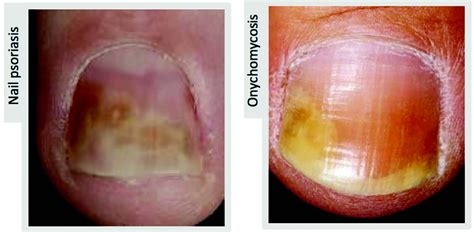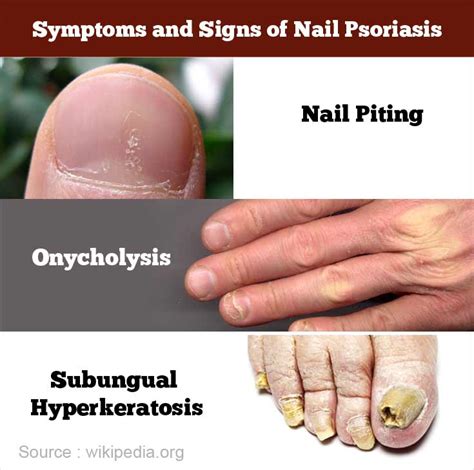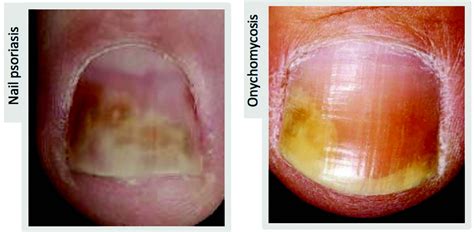Intro
Discover Psoriatic Nail Disease symptoms, including nail pitting, onycholysis, and subungual hyperkeratosis, and learn about treatment options for this chronic condition affecting nail health and psoriasis sufferers.
Psoriatic nail disease is a common condition that affects millions of people worldwide, particularly those who suffer from psoriasis. It is estimated that up to 50% of people with psoriasis will develop nail symptoms at some point in their lives. The condition can cause a range of symptoms, from mild discoloration to severe pain and disability. In this article, we will delve into the world of psoriatic nail disease, exploring its causes, symptoms, and treatment options.
The importance of understanding psoriatic nail disease cannot be overstated. For many people, the condition can have a significant impact on their quality of life, causing embarrassment, discomfort, and difficulty performing everyday activities. Furthermore, if left untreated, psoriatic nail disease can lead to more serious complications, such as nail loss, infection, and even arthritis. By learning more about the condition, individuals can take the first step towards seeking effective treatment and managing their symptoms.
Despite its prevalence, psoriatic nail disease remains poorly understood by many people. The condition is often mistaken for other nail disorders, such as fungal infections or nail trauma. However, with the right knowledge and diagnosis, individuals can receive the treatment they need to alleviate their symptoms and improve their overall health. In the following sections, we will explore the causes, symptoms, and treatment options for psoriatic nail disease, providing readers with a comprehensive understanding of the condition.
What is Psoriatic Nail Disease?

Causes of Psoriatic Nail Disease
The exact causes of psoriatic nail disease are not fully understood, but it is believed to be related to the abnormal immune response that occurs in psoriasis. In psoriasis, the immune system mistakenly attacks healthy skin cells, leading to inflammation and damage. This inflammation can also affect the nails, causing a range of symptoms. Other factors, such as genetics, environmental triggers, and certain medications, may also contribute to the development of psoriatic nail disease.Symptoms of Psoriatic Nail Disease

Types of Psoriatic Nail Disease
There are several types of psoriatic nail disease, including: * Nail psoriasis: This is the most common type, characterized by nail thickening, discoloration, and pitting. * Nail bed psoriasis: This type affects the skin under the nail, causing inflammation and damage. * Psoriatic nail dystrophy: This type causes the nail to become thickened and deformed, leading to pain and discomfort.Treatment Options for Psoriatic Nail Disease

Home Remedies for Psoriatic Nail Disease
In addition to medical treatment, there are several home remedies that can help alleviate symptoms of psoriatic nail disease. These include: * Keeping the nails clean and dry * Avoiding harsh chemicals * Wearing comfortable shoes * Applying topical creams and ointments * Taking dietary supplements, such as omega-3 fatty acids and vitamin DLiving with Psoriatic Nail Disease

Coping with the Emotional Impact of Psoriatic Nail Disease
Psoriatic nail disease can have a significant emotional impact on individuals, causing feelings of embarrassment, anxiety, and depression. However, there are several things that individuals can do to cope with these emotions, including: * Seeking support from friends and family * Joining a support group or online community * Practicing stress-reducing techniques, such as meditation and yoga * Focusing on positive self-image and self-esteemWhat are the symptoms of psoriatic nail disease?
+The symptoms of psoriatic nail disease include nail thickening, discoloration, pitting, onycholysis, and subungual hyperkeratosis.
How is psoriatic nail disease treated?
+Treatment for psoriatic nail disease typically involves a combination of topical and systemic medications, as well as lifestyle changes.
Can psoriatic nail disease be cured?
+While there is no cure for psoriatic nail disease, treatment can help alleviate symptoms and improve quality of life.
How can I prevent psoriatic nail disease?
+While there is no sure way to prevent psoriatic nail disease, individuals can reduce their risk by maintaining good nail hygiene, avoiding harsh chemicals, and managing stress.
What are the complications of psoriatic nail disease?
+Complications of psoriatic nail disease include nail loss, infection, and arthritis.
In conclusion, psoriatic nail disease is a common and often debilitating condition that affects millions of people worldwide. By understanding the causes, symptoms, and treatment options for the condition, individuals can take the first step towards seeking effective treatment and managing their symptoms. Whether you are living with psoriatic nail disease or know someone who is, it is essential to stay informed and take action to improve your quality of life. We invite you to share your experiences, ask questions, and join the conversation to raise awareness and support for those affected by psoriatic nail disease.
